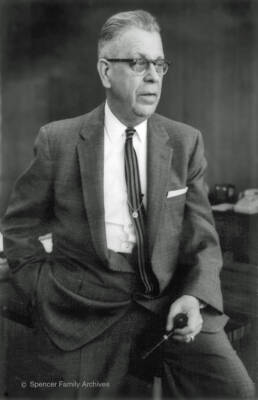These life stories may contain descriptions of childhood trauma and abuse, as well as images, voices and names of people now deceased. If you need help, you can find contact details for some relevant support services on our support page.
American physicist and inventor of the microwave oven, Percy Spencer (1894-1970), was in kinship care as a child.
Percy Lebaron Spencer was born in Howland, Maine. His father died in 1896 and their mother separated Percy and his older brother, John (b. 1892) and sent them to live with relatives. Percy’s Uncle John died when the boy was 7 years of age.
At the age of 12, Percy Spencer left school and began to work in a weaving mill to help support himself and his Aunt Minnie. He became an autodidact, teaching himself electrical work; two years later Percy was hired to install electricity in a paper mill.
Percy Spencer joined the US Navy in July 1912 and worked for 2 years as a radio operator, while teaching himself physics from textbooks. He was discharged from the Navy after two years because of a chronic ear condition and took a position at the Wireless Specialty Apparatus Company in Boston.
In 1925, Spencer joined the American Appliance Company, which later became the Raytheon Company. Percy’s brother, Al (as John was known), also an inventor, was already working for Raytheon. During WWII, the Raytheon Company was contracted to produce combat radar equipment for the British and Spencer developed a way by which the central component for radar, the cavity magnetron, could be mass produced. For his contribution to the war effort, Percy Spencer received the Distinguished Public Service Award from the US Navy.
One day in 1945 while Percy Spencer was working in a laboratory testing a magnetron—an electron tube for generating microwaves—he noticed that a bar of confectionary in his pocket was melting.
Rod Spencer, grandson of Percy Spencer and himself an inventor, says:
“So he put two and two together and he decided to get some popcorn, so he sent the popcorn in and it starting popping all over the place…The next morning, he brought in an egg. One of the engineers who was a little disbelieving in terms of a microwave’s ability to cook, just as he was looking over, the egg blew up in his face” (Tweedie).
Percy Spencer and his employer, Raytheon Company, patented Spencer’s idea that year and the first microwave oven, called the “RadaRange,” was launched in 1947. Because of its size and weight—it was comparable to the size of a fridge at almost 182 cm tall and weighing 340 kg—the microwave did not become popular until it was designed for the domestic market in 1955. By 1975, sales were greater than for gas ovens and by 1986, a quarter of American households owned a unit.
Percy Spencer retired from Raytheon in 1964 by which time he was a senior vice president of the company.
In 1999, Percy Spencer was inducted into the National Inventors Hall of Fame.
References:
Blitz, Matt. “The Amazing True Story of How the Microwave Was Invented by Accident.” Popular Mechanics, 2 September 2021. https://www.popularmechanics.com/technology/gadgets/a19567/how-the-microwave-was-invented-by-accident/
Smith, Monica. “The Devil Is in the Details: Researching an Inventor’s Biography.” Lemelson Centre for the Study of Invention and Innovation, Smithsonian National Museum of American History. https://invention.si.edu/devil-details-researching-inventor-s-biography
Percy Spencer. Physicist, Cambridge, MA. Atomic Heritage Foundation. https://www.atomicheritage.org/profile/percy-spencer
Tweedie, Steven. “How the microwave was invented by a radar engineer who accidentally cooked a candy bar in his pocket.” Business Insider Australia, 4 July 2015. https://www.businessinsider.com.au/how-the-microwave-oven-was-invented-by-accident-2015-4?r=US&IR=T
Image from here
